Henry B. du Pont Preservation Shipyard

Celebrating 50 Years FALL/WINTER | 2022
Fund

To make your gift today, please call 860.572.5365, email advancement@mysticseaport.org, or visit www.mysticseaport.org/support We need your SUPPORT by December 31, 2022. Your generous Annual
gift has direct and profound impact on everyone who visits Mystic Seaport Museum. Our visitors love the exhibits, the waterfront, our summer camps, the library, online programming, and our working shipyard. You and your gifts support it all. THIS EXHIBIT IS MADE POSSIBLE BY YOU.
MYSTIC SEAPORT MUSEUM MAGAZINE
is a publication of Mystic Seaport Museum.

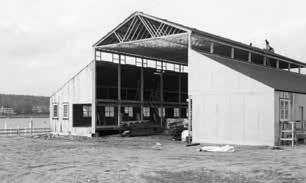
PRESIDENT
Peter Armstrong
CHAIRMAN OF THE BOARD
Michael Hudner
ASSOCIATE EDITOR
Sherri K. Ramella
editor@mysticseaport.org
DESIGN
Susan Heath CONTRIBUTORS
Peter Armstrong Christopher Bresky
Christina Connett Brophy, Ph.D. Sarah Cahill
Sarah Clement
Libby Daly
Chris Freeman
Arlene Marcionette
Sophia Matsas
Emily Mayotte
Shannon McKenzie Margaret Milnes
Kevin O’Leary
Quentin Snediker Greg Zabel
PHOTOGRAPHY
Joe Michael Mystic Seaport Museum Archives

Captain William (Bill) Pinkney

Andy Price
ON THE COVER
Friendship Sloop Estella A. hauled on the shiplift prior to being moved to the Armstrong Workshop on Siegel Point for extensive restoration to begin this winter (2022-2023). Estella A. was built by R.E. McLain at Bremen Long Island Maine in 1904. (1957.498)
CONTACT US
Visitor Information: 860.572.5315
Administration: 860.572.0711
Advancement: 860.572.5365


Membership: 860.572.5339
Program Reservation: 860.572.5331 Museum Store: 860.572.5385 Volunteer Services: 860.572.5378
Please go to the Museum’s website for information on Spring and Summer schedules.
CONTENTS
75 Greenmanville Avenue Mystic, CT 06355-0990 www.mysticseaport.org
IN


Flexing
The America
Mussels
Summer Interns
EVERY ISSUE VIEW FROM THE BRIDGE 4 MUSEUM NEWS 6
our
Free Admission for Kids New Docks at WoodenBoat Show
and the Sea Award Gala Member Survey and Evening Events
Tell an Inclusive Story Juneteenth DONOR IMPACT 11 The CEE Changes Lives UPCOMING EVENTS 24 FEATURES HENRY B. DU PONT PRESERVATION SHIPYARD: CELEBRATING 50 YEARS DIGITIZING THE COLLECTION 18 PRESERVATION OF THE ROSENFELD COLLECTION 19 GLOBAL OUTREACH 20 GFOE: INSPIRATION THROUGH EXPLORATION 21 HOLIDAY GIFT GIVING 22 12 19 18 22 12
A Message from the President
“Shipbuilding is indigenous to the Mystic Valley. Wood takes to water very naturally here ... and sometimes men talk together of the ships that they build and owned and sailed, and speak with kindness in their voice, as men speak of their own children.” - William Allen Wilbur 1899
The shipyards of Mystic were the center of commerce and the center of the community, just as the current shipyard here is the beating heart of the Museum. In this edition, we celebrate 50 years since Howard Davis, long-time shipwright, began the work that has led us to the thriving Henry B. du Pont Shipyard we see today with a combination of modernday techniques and the passing of traditional skills to a new generation.
Mystic Seaport Museum continues to celebrate the past, works in the present, and helps shape the future. The pages of this edition, exemplify this by including the exciting digitization work we are carrying out to open up our Collections to others worldwide through the digital universe—an ambitious plan to open the vaults and share our treasures.
I have never been one to believe the argument that if you allow people to view and explore the collection, why would they come to visit. If that were true, no one would line up for a brief glimpse of the Mona Lisa or travel halfway across the world to see the pyramids of Giza. It is in our very nature to want to experience the real thing: walk on the decks of the Charles W. Morgan, sail on the Mystic River, and marvel at the skills of our shipwrights. You will see on the pages of this magazine that the Museum’s community of staff, volunteers, members, donors, and trustees continue to work to provide authentic experiences.
I will end with another quote showing how the Museum creates maritime moments for everyone.
“One particular day stands out, when my parents were old, both in wheelchairs. My two teen daughters were pushing the wheelchairs and I was pushing my youngest daughter in a stroller. It was a great day. Everyone was excited about something completely different—experiencing it together made everyone catch each other’s excitement. Things we didn’t always pay much attention to were suddenly more interesting because of each other’s excitement.”
Peter
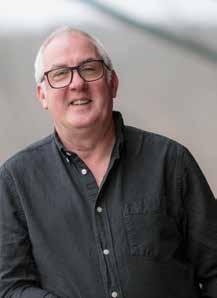

4 / View from the Bridge


Sargent, Whistler, and Venetian Glass: American Artists and the Magic of Murano is organized by the Smithsonian American Art Museum. Generous support has been provided by the Gladys Krieble Delmas Foundation, the Embassy of Italy in Wash ington, D.C., Chris G. Harris, the Raymond J. and Margaret Horowitz Endowment, Janet and William Ellery James, William R. Kenan Jr. Endowment Fund, Maureen and Gene Kim, the Lunder Foundation—Peter and Paula Lunder Family, Lucy S. Rhame, Holly and Nick Ruffin, the Smithsonian Scholarly Studies Awards, Rick and Lucille Spagnuolo, and Myra and Harold Weiss. The accompanying catalog is supported in part by Jane Joel Knox. The exhibition is supported by an indemnity from the Federal Council on the Arts and the Humanities. In-kind support has been provided by Christie's. John Singer Sargent, A Venetian Woman, 1882, oil on canvas, 93 3/4 x 52 3/8 in., Cincinnati Art Museum, The Edwin and Virginia Irwin Memorial, 1972.37 ON EXHIBITAmerican Artists and the Magic of Murano Sargent, Whistler Venetian Glass & ON EXHIBITOCTOBER 15-FEBRUARY 27 Collins Gallery Member Mornings 9:00 am —11:00 am October 17-22
Our Mussels on Instagram FLE X ING
23 Million Views
If you follow our Instagram or TikTok you will get an inside glimpse of the everyday happenings in the Shipsmith, Cooperage, Collections, Shipyard, summer camps, and more. We’ve received great feedback and inter action, but one video was a huge hit and has garnered nearly 23 million views! When thinking about work in the Shipyard, one may consider wood planks, saws, nails, and hammers, but what about mussels? That’s right, on the recent hauling of Victory Chimes, shipwrights were hard at work scraping mussels off the bottom of the hull and social media was en thralled by the process. Follow us on Instagram and TikTok to share this video and stay up to date on all the latest at the Museum!
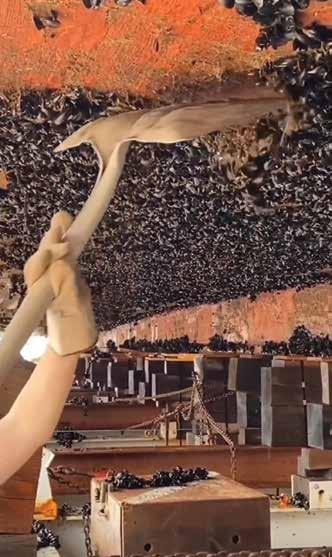
Haven’t seen it? Watch it here.
Free Admission For Kids
Thanks to federal funding from the American Rescue Plan Act administered by the Connecticut Department of Economic and Community Development’s Office of the Arts in partnership with Connecticut Humanities, the Connecticut Summer at the Museum program, designed to get kids out of the house and into museums, returned for the second year. Over 15,000 Connecticut res idents took advantage of free admission to Mystic Seaport Museum this summer. During the last two summers, we have seen a boost in admissions thanks to the program, and visiting families have been able to take advantage of add-on offerings including Planetarium shows, Liberty rides, and toy boat building.
Although this program concluded on Labor Day, Mystic Seaport Museum is pleased to announce a pilot program designed to encourage people of all backgrounds to enjoy access to the Museum. We are grateful to a group of donors who have enabled us to offer free admission to SNAP/EBT recipients this fall. We are now partnered with the Institute for Museum and Library Science (IMLS) and their Museums for All program through the end of the year, and hope to continue this effort beyond the pilot program. Tickets may be obtained online at mysticseaport.org/tickets or at the admissions desk.
6 / Museum News
New Docks Create a Bustle at the 30th Annual WoodenBoat Show
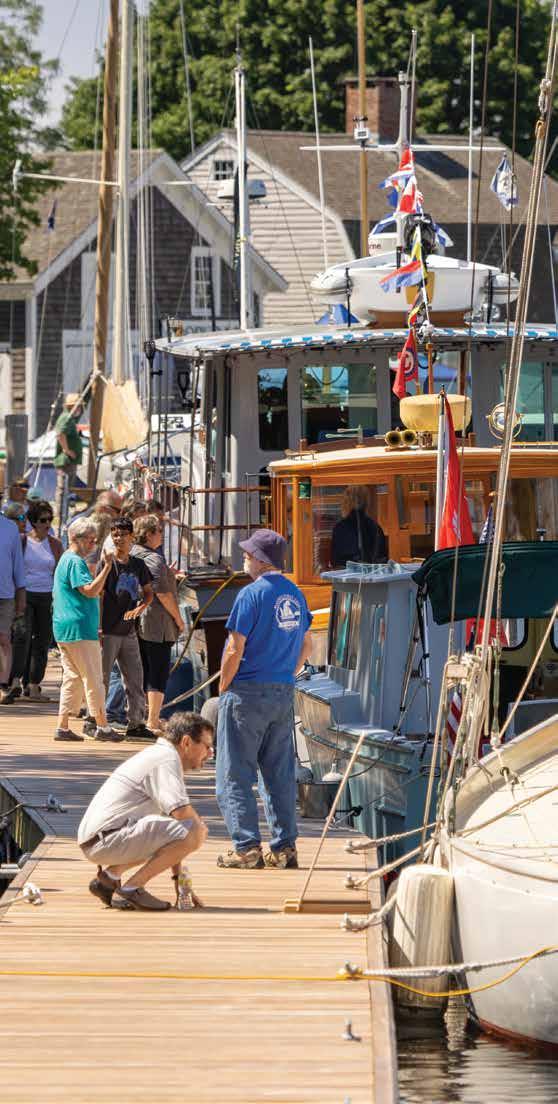
Museum grounds have been bustling thanks in part to the spring completion of the renovation of the Cruising Club of America (CCA) Dock providing an additional 200 feet of dock space, allowing for an average of 6 additional boats per night. The new floating docks are safer, more user-friendly, and conducive to a wider range of boaters including those who may have mobility challenges. Initial feedback from dock visitors has been incredibly positive.
In 1948, CCA Commodore Thorvald Ross joined Museum Chairman P.R. Mallory in dedicating the Cruising Club of America Dock at Mystic Seaport Museum. Founded in 1922, the CCA has more than 1,400 members. In the last 75 years, tens of thousands of boaters have visited to enjoy the Museum by day and witness the magic at night that only those visiting by boat can experience.
As we celebrate our 75-year relationship with CCA, we unveiled the new docks to commemorate the CCA’s Centennial and our shared appreciation of America and the sea.
Since the completion of the renovation in the spring, we have welcomed an additional 800 boats to the Museum. The floating docks also will enable the Museum to keep pace with the environmental changes presented by rising sea levels well into the future. Electrical upgrades to all dock areas are also in progress.
WOODENBOAT SHOW
The additional length of the floating docks allowed more boats than ever to participate in the 30th Annual WoodenBoat Show, held in partnership with WoodenBoat Magazine, June 24-26. Boats of all types were on display, from the 14' tug boat Little Toot to the 120' replica schooner Amistad. Skills demonstrations in blacksmithing, boatbuilding, steam-bending wood, and much more took place in the Henry B. du Pont Preservation Shipyard. A speaker series in the Masin Conference Room shared stories of privateering in the American Revolution and a family’s circumnavigation aboard their home-built engineless replica of Captain Joshua Slocum’s famous yawl Spray, the restoration of the 1930 Herreshoff Cirrus and the 1905 yacht Doris, and the development of Maine’s iconic double-ended peapods for lobstering. Opportunities to get out on the water abounded in the Small Craft Workshop, waterfront tours on Liberty, and the chance to be your own captain on traditional small crafts at the Boathouse. The Watercraft Hall was open to the public for rare access to nearly 500 historic vessels. Look for this annual event in 2023 and come by boat if you can!
Museum News / 7
The America and the Sea Award Gala honoring Captain Bill Pinkney, October 26, 2022

Mystic Seaport Museum is pleased to present the 2022 America and the Sea Award to Captain William “Bill” Pinkney, former Mystic Seaport Museum trustee, U.S. Navy Hospital Corpsman, sailor, educator, author, and adventurer. An ambassador to those who believe the maritime world is not for them, he has proven adept at showing everyone that the sea connects us all. Captain Pinkney recently released a children’s book titled Sailing Commitment Around the World with Captain Bill Pinkney, cele brating the 30th anniversary of his return from the 27,000-mile, 22-month solo circumnavigation. His full biography can be read at www.mysticseaport.org/gala.
The award will be presented at a black-tie gala on October 26 at the Metropolitan Club in New York City. The celebratory event will begin with a cocktail reception with the honoree, followed by dinner, award presentation, auction, and paddle raise. Sponsorships range from $10,000 to $50,000; single tickets are $1,000. For more information on the honoree or event, or to purchase tickets, please email advancement@mysticseaport.org or visit msmgala22.givesmart.com. The deadline for purchasing tickets is October 19.
We sincerely thank the following sponsors (as of September 9, 2022).
PLATINUM
Betsy and Hunt Lawrence GOLD
J. Barclay Collins, II Joanne and Michael Masin
Travelers
SILVER
Peggy and Grant Cambridge Glenmede Endowment and Foundation Management
Michael S. Hudner
BRONZE
Maarten de Jong and Kendra Matthew Renate and Peter Gleysteen Gowrie Group
Charles J. and Irene Hamm
Cynthia and Robert Martin
Sheila McCurdy and David Brown Cayre and Alexis Michas
Robert Musetti and Carol Allison-Musetti
Laurie Olson and Maria Fasulo
Rosemary and Richard Vietor & Betsy and George White
8 / Museum News
Membership Survey
In June we conducted our 2022 Membership Survey via email. Our goal was to learn more about you— what you enjoy most about Mystic Seaport Museum and what we can do to improve your Membership experience. We cannot thank you, our Members, enough for your thoughtful, considered, and generous responses.

When we asked why Mystic Seaport Museum is important to you, 33% of you wrote about profound in tellectual connections—from researching your family history in the library to your abiding passion for maritime history. Another 28% of you called out the importance of the Museum’s mission or our service to our community. The rest of you who responded, another 39%, wrote about your feelings—a beloved family memory, a cherished moment with a vessel or a staff person, an experience that changed you forever for the good. A sampling of your thoughts is shared throughout these pages.*
Defined by humor, love, and insight, your feedback will be returned to again and again for our inspira tion. Know that where we can, we will implement your many ideas to ensure your experience here gets even better. Membership is one of the founda tions upon which our Museum rests. We are forever grateful for your support and commitment to our mission and community.
*In some cases quotes have been edited for clarity. We are unable to credit individuals because the survey was anonymous.
Member Evenings

Have you experienced a Member evening? If you haven’t, keep an eye out for our announcements next year. You won’t regret it. We’ll post the dates and details in our newsletters and on the Members’ Facebook page.
This year we held two—our 2nd annual summer sol stice celebration on a Saturday in June and our 5th annual Member Appreciation Evening in September. These Member-only open evenings are our favorite events. Members bring picnics or pizzas, or enjoy a drink on the deck while listening to music. We host a variety of family-friendly activities, and keep new exhibits open for Members’ private viewing, often with a curator or seasoned interpreter on hand. The Boathouse and the Charles W. Morgan are always open. The vibe is relaxed, friendly, and unique—it is truly a rare treat to enjoy the Museum grounds at sunset. And it’s all included in your Membership! it’s just one way we say thank you for your ongoing support and generosity.
MEMBERS
Join us!
Museum News / 9
“The Museum is important to me because of the history it reveals. The stories behind the history. The special events. The friendly and informative people you encounter there. The wonderful, relaxing, and exciting atmosphere it establishes, and more.”
-
Museum Member
Discovering Amistad Collaboration
Juneteenth Summer Interns Tell a More Inclusive Story
Mystic Seaport Museum and Discovering Amistad collaborated for the third year to recognize Juneteenth, a federal holiday in the United States commemorating the emancipation of enslaved African Americans. On Sunday, June 19, special programming on the grounds of the Museum included an educational panel discussion, a period for reflection, live drumming, dancing, music, arts and crafts, and guided tours aboard Amistad, the 128-foot flagship of Connecticut often on display at the Museum. The event was designed to honor African American culture, increase awareness, and highlight the roles that we all can play to dismantle racism.
Over 200 attendees gathered at the Tom Clagett Boat Shed to recognize this important date in history, and there was a palpable energy in the air. With thanks to our sponsors, Chelsea Groton Bank and the Community Foundation of Eastern Connecticut, we were pleased to be able to extend free admission to those who came to participate in the day’s activities.
People and nations of the world—while diverse in their own rich histories and cultures—are connected by the sea. Juneteenth and associated programs take on new relevance and meaning each year and provide opportunities for new audiences to find their personal connections to our maritime past.
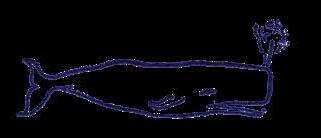

This year’s summer internship pro gram was part of the multi-year Re imagining New England Histories: Historical Injustice, Sovereignty, and Freedom project, generously funded by the Just Futures Initiative of the Mellon Foundation. Six interns made up the team: Anujot Kaur, Bridget Hall, Cheyenne Tracy, Liz Ferrara, Lydia Downs, and Spencer Krenitsky. Together they worked to tell a more inclusive story of New England maritime history at the Mu seum. The interns met with the ex ecutive director of the Mashantuck et Pequot Muse um and Research Center, Joshua Carter, and tribal members to plan several of their projects. During their internship, the team built an interactive guest experience high lighting Cape Verdean whaling culture and the life of the last master of the Charles W. Morgan, a Cape Verdean whaling captain named John Teofilo Gon salves. The interactive experience is titled To Brava and Back: Navigate the True Story of a Cape Verdean Whaleman. As an act of reciprocity with Indigenous partners, the Mel lon interns assisted the Tomaquag Museum in the creation of a digital inventory of their collection. These students also brought a diverse re interpretation of foodways to the Buckingham-Hall House, wove In digenous and Black oystering sto ries into the Thomas Oyster House, and planted on the Museum grounds
new gardens rooted in African and Indigenous maritime culture.
Frank C. Munson Institute classes also were a part of the Reimagin ing New England Histories: Historical Injustice, Sovereignty, and Free dom project. Program participants included museum profession als, Ph.D. students, school teach ers, and associate professors from the University of Dayton and the U.S. Naval Academy. In col laboration with the Center for the Study of Slavery & Justice at Brown University and Williams College, classes were held at Mystic Seaport Museum and field seminars at the Mashantucket Pe quot Museum and Research Center in Mashantuck et, Connecticut, Sylvester Manor in Shelter Island, New York, and in New Bedford, Massachusetts, Newport, Rhode Island, and New London, Connecticut, to interrogate the region's past. The history and legacies of settler colonialism, racial slavery, servitude, dispossession, Indigenous resistance, and African American strategies for fashioning pursuits of freedom were present ed by numerous noteworthy guest lecturers, scholars, and communi ty members. A distinctive feature of this summer program was the framing of these topics within the context of New England’s maritime setting.
“A very sincere thank you for putting on this program, raising these discussions, and letting me be part of it all. Challenging, affirming, and meaningful, this institute was exceptional for me.”
— program participant, scholar, and teacher
10 / Museum News
The CEE Changes Lives
The Museum’s new Center for Experiential Education (CEE) strives “to engage under-resourced youth in experiential mari time education anchored in positive youth development to help them enhance their social, emotional, and leadership skills.” Through CEE programming, students build resilience and develop essential skills such as leadership, communication, teamwork, problem-solving, and critical thinking through team projects in boat-building, sailing and powerboat operation, astronomy and navigation, and becoming stewards of our waters through marine science.
The Maritime Adventure Program (MAP) is a more intensive com ponent of CEE. The inaugural pilot MAP cohort launched with nine high school students affiliated with New London Youth Affairs (NLYA) this past spring. Programming promotes teambuilding and leadership skills through a curriculum that includes a new challenge course, rowing, marine carpentry, and sailing. Twelve students from New London Youth Affairs, including some of the members of the pilot youth cohort, worked this summer at the Museum through the summer youth employment pipeline that is an integral component of CEE.
Two students who participated in the spring MAP and worked at the Museum this summer spoke about their experience. A.M. is a rising high school sophomore who has spent much of her youth on and near the waters of Connecticut and North Carolina. With an interest in marine sciences, having the opportunity to join the Mystic Seaport Museum Maritime Adventure Program has been an exciting adventure for A.M. She describes the structure of the program as one that brings people with different backgrounds together in a respectful, encouraging environment that promotes teamwork rather than competition. A.M. spent five days onboard Brilliant and describes the experience as “life-changing.” She admitted that she probably would have been afraid to try sailing a boat on the open ocean for a week with 11 strangers, because
“meeting new people has always been scary since you don’t know if they’re going to like you or how they’re going to treat you.” But, being part of the Center for Experiential Education, where people are caring and “don’t talk to me like I’m incompetent,” gave her the self-confidence to try something new.
K.C. is also a rising high school sophomore who participated in MAP through the New London Youth Affairs partnership. K.C. has a wide range of interests in school, but interacting with strangers has always been difficult for her. However, after several months of participating in MAP, she feels she has more confidence and better communication and negotiation skills. She credits that transformation to the hands-on activities, group projects, variety of opportunities to learn something new, and the general feeling of being supported as part of a team in MAP. She noted that this is an opportunity that wasn’t necessarily available to her: “I might not have had the chance to work here because I might not have known there was anything here that would interest me.” She also shared, “There are many people who are very grateful from New London Youth Affairs that they’re able to come here.”
A.M. and K.C. have learned skills such as paint removal, painting, varnishing, boat repair, knot tying, rowing, and sailing, but it’s the soft skills in self-confidence, leadership, communication, team work, problem-solving, and critical thinking that they recognize as the most impactful. A.M. shared that she now has a life goal of buying a sailboat and one day sailing around the world thanks to the MAP opportunity that “opened my eyes to experiences unimagined.” K.C. is looking forward to participating more confi dently in the environment club in school and excitedly described the club’s goal of building a city garden in Groton that will be used to explain environmental issues and what individuals can do to address those issues. Their experience and growth are shining examples of what is made possible by the generous support of our members and donors to the Museum. Thank you!

The MAP opportunity “opened my eyes to experiences unimagined.” / 11 Donor Impact / 11
Students in the Maritime Adventure Program learning about boats and marine carpentry.
HENRY B. DU PONT PRESERVATION SHIPYARD

PONT

CELEBRATING 50 YEARS
“It is the very heart of this community.” - Museum Member
THIS PAGE: Kalmar Nyckel, hauled on our Shiplift. This vessel is a modern re-creation of the 17th-century Swedish vessel that carried the first settlers to what is now Delaware in 1634. In our new role the Shipyard has become the shipyard of choice for many such vessels seeking infrastructure and skills for inspection, maintenance, and repair.
PREVIOUS PAGE: Our Noank Fish and Lobster boat Star, built by Robert Whittaker in 1950 to a design typical of the era, in the Main Shop for restoration. Star was originally acquired as a Shipyard work boat but is now considered part of our historic collection. It is still powered by its original Lathrop engine. (1976.231)

14 / Feature
The Henry B. du Pont Preservation Shipyard: A Retrospective of Fifty Years
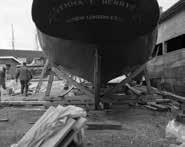

 By Quentin Snediker, Clark Senior Curator for Watercraft
By Quentin Snediker, Clark Senior Curator for Watercraft
The year 2022 marks the 50th anniversary of the opening of the Henry B. du Pont Preservation Shipyard at Mystic Seaport Museum, the first shipyard built specifically for preservation in the United States, and possibly the world, marking a new era in maritime preservation.


Watercraft preservation at the Museum began with the acquisition of our first vessel, the sandbagger Annie, in 1931. In these early years, local boat builders were contracted to maintain the small but growing fleet. When we acquired the Charles W. Morgan a decade later our maintenance and preservation responsibilities grew exponentially. At first, most work was accomplished by local Boy Scout and Sea Scout groups led by a few facilities staff, begin ning a legacy of volunteer participation that continues to this day.
By the late 1950s, our fleet grew to nearly 30 watercraft and with it, four staff positions were created to meet the care demands. During these years, maintenance took place in the area now known as Siegel Point and Scott’s Wharf, near the Lighthouse, site of the former George Greenman & Company Shipyard. Larger vessels like the Joseph Conrad and L.A. Dunton were taken to New London’s Thames Shipyard for haul-out.
In the 1960s attitudes toward historic preservation underwent a nationwide sea change with the passage of the National Historic Preservation Act of 1966. By then the Museum’s fleet had grown to over 100 watercraft and we became a leader in the maritime preservation movement.
With concerns for long-term preservation and diminishing capabilities to care for wooden ships in the commercial world, Museum Trustees began to study the feasibility of creating our own shipyard. Such notables as Waldo Howland, John Leavitt, “Pete” Culler, Irving Johnson, and Olin Stephens, among others, argued passionately in favor of this significant commitment. In the spring of 1970, the Board approved the project. Funding was provided by the family of the late trustee Henry B. du Pont and the facility was named in his honor. By then the fleet had grown to nearly 160 watercraft. It is hard to decide what milestone marks the anniversary of the long process resulting in “the Shipyard,” but for our purposes, we’ve called it January 2, 1972, the day Howard Davis, long-time shipwright, recalled moving his toolbox from the Point into the new Shipyard Main Shop.
Our first major project was hauling the Morgan to restore it to floating condition in 1974. Next to follow were re-topping the L.A. Dunton, restoring Sabino, and re-decking the Joseph Conrad. Through the following decades all of our floating watercraft had their turn in the shop; Emma C. Berry, Florence, Regina M., Annie, Nellie, Star, and Roann. Eventually, about every thirty years, major work is required on nearly all wooden vessels, and by now some have been in the Shop twice. In addition, we’ve built new replica crafts—whaleboats, dories, lifeboats, and others—to support our educational programs. One of our greatest accomplishments was building Amistad, launched in 2000.
(Left) Shipwrights Basil Tuplin and Roger Hambidge “getting out” a plank for the Charles W. Morgan during the topside rebuild in 1980. (Second from Left) National Historic Landmark steamboat Sabino being “skid” into the Main Shop on greased planks for extensive restoration in 1978. (Third from Left) Unstepping masts of the Charles W. Morgan in January 1974 prior to being freed from the sand berth where it had been since 1941. The Morgan has been afloat since that time and completed a 38th Voyage in 2014. The Charles W. Morgan was named a National Historic Landmark in 1967. (Second from Right) Noank sloop Emma C. Berry undergoing restoration in 1971 at what is now known as Siegel Point, former site of the George Greenman Shipyard. (Right) Stern view of the Emma C. Berry nearing the end of this restoration. Built in 1866 at the R. & J. Palmer yard in Noank, this vessel was named a National Historic Landmark in 1994.
Feature / 15
By 2007, after more than 30 years of reliable service, we needed to replace our shiplift, a major investment, but absolutely necessary to continue our work. The new ship lift gave us the capability to work on more than one large vessel at a time, allowing us to haul additional vessels for maintenance and repair during the recent five-year Morgan restoration. This also allows us to bring in outside vessels for maintenance, producing a new income stream for the Museum.
In recent years commercial shipyards have been more and more reluctant to take on wooden vessel projects, even simple routine haul-outs. Our capability has been a great benefit to the maritime community and to the Museum not only through income, but allowing us conti nuity of workforce and a steady stream of material supply. This was especially important during the recent pandemic when our work was considered an “essential service,” allowing work to go on when all else was shut down.
In 2011 we began discussions with Plimoth Patuxet (formerly Plimoth Plantation) about the possibility of a major restoration for Mayflower II, built in 1956. Soon after Morgan’s 38th voyage, Mayflower II was hauled at the Shipyard for a thorough survey. We found it was in need of significant work. The vessel came each winter for the next two years for preliminary work, as Plimoth raised neces sary funds and we gathered materials. This project was an ideal collaboration between Mystic Seaport Museum and Plimoth, their crew working side by side with our ship wrights for what grew to be a three-year project replacing about 70% of the vessel’s structure.
The next projects included major work on the 1942 fish ing schooner Sherman Zwicker, replacing stern struc ture, planking, and thorough caulking. Pilot, built in 1924, followed with major re-planking and caulking. Both vessels serve as floating oyster restaurants in New York City for the same owners. Next came Shenandoah built in 1964, formerly a passenger vessel, now a not-for-profit educa tion ship, for a rebuild of its elegant stern, re-planking, and again caulking. Last winter Pilot returned for re-decking and Mayflower II returned for routine haul-out and in spection. We have become the shipyard of choice for many large wooden vessels, and demand for our skills and talent is growing.
As an example of how important this facility is to other vessels, the passenger schooner Victory Chimes, built in 1900, and Kalmar Nyckel, built in 1997 as a re-creation of a 17th-century Swedish ship, travel several hundred miles for work at our Shipyard. Kalmar Nyckel returned this summer.
One of the unique aspects of our Shipyard is that our work is not a revival of skills as it has been elsewhere. There is a continuity unlike any other. Our first generation of crafts people grew up when wood and natural materials were the principal medium for ships and boats. They taught the next generation who then, in turn, taught people of the current generation. Now we’re passing those tradi tional skills on once again in a direct line from the age of wooden ships. This has an unseen added value of culture, the subtlety of skills and techniques, and appreciation for wood and the vessels created from it found nowhere else.
Looking forward, we will continue to be the premier resource for wooden ships, and maintain our own fleet— both the ships and the skills necessary to preserve them.

Our first generation of craftspeople grew up when wood and natural materials were the principal medium for ships and boats. They taught the next generation who then, in turn, taught people of the current generation. Now we’re passing those traditional skills on once again ...
16 / Feature

We have become the SHIPYARD OF CHOICE for many large wooden vessels, and demand for our skills and talent is growing. Feature / 17 PREVIOUS PAGE: Shipyard crew pitch in to scrape the bottom of Mayflower II before moving to the workstation for maintenance and repair. THIS PAGE: After three years of restoration the fabric cover is removed from Mayflower II prior to launching in 2019.
DIGITIZ ATION

The conversion of text, pictures, or sound into a digital form that can be processed by a computer.
By Kevin O’Leary, Vice President of Business Development and Marketing
Mystic Seaport Museum, like countless other cultural or ganizations, wages a battle for relevancy each and every day. How does a legacy institution like Mystic Seaport Museum connect with and grow an audience increasingly distracted in today’s metaverse of streaming entertain ment, connectivity, and community?
One solution is to honor the Museum’s founding mission by celebrating America’s maritime history—digitally. With less than 3% of our collection being exhibited at any given time and a seemingly unquenchable demand for compelling and authentic content throughout the world, we have an opportunity and duty to share our collection with an audience on an extraordinary scale. Enthusiasts, educators, researchers, students, and the simply curious should all have an opportunity to access and enjoy the Museum’s extensive collection.
How extensive? Consider these numbers: two million pieces of maritime art, artifacts, tools, buildings, imprints, documents, and photographs (including the incomparable Rosenfeld Collection); 1,000 ships’ registers; 600 audio taped oral history interviews; 200 videotaped interviews; and almost 2 million feet of historic & contemporary maritime-related footage. In short, our Intellectual Property and Archives collections are staggeringly large. They should be shared with the world.
Sharing the collection will take work. The Museum’s Collections Research Center team has embarked on a massive, multi-year digitization project with Heritage Werks, a state-of-the-art archival agency with extensive, proven experience in digital preservation with Fortune 500 companies, the National Archives Museum, Major League Baseball, and others.

Together with the team at Heritage Werks, Mystic Seaport Museum is working to create a user-friendly, self-service digital archive featuring photos, film, documents, and objects that are ready-referenced and searchable across limitless parameters. This will allow the Museum to con nect with a worldwide audience on a scale unimaginable 20 years ago, including greater e-commerce opportunities and potential business and strategic partners that would benefit from our extensive collection of still and moving images. In preparation, we have conducted preliminary discussions with Red Bull Media, PBS, Discovery Educa tion, BBC, and others. The response has been positive, but we have work to do before we swim in those proverbial waters.
Digitization of this scale represents considerable com mitment but one that is crucial to the future growth and livelihood of Mystic Seaport Museum. Our collection is one that lends color and context to the stories we tell each and every day here at the Museum, and we view digitiza tion as a massive gateway into our maritime world for the next generation of members, visitors, and donors.
18 / Feature
CONSERVING
By Emily Mayotte, Rosenfeld Collection Conservator and Cataloger
The Rosenfeld Collection, built from the work of Morris Rosenfeld and sons, was acquired in 1984 by Mystic Seaport Museum and is one of the largest archives of maritime photographs in the United States. This Collection contains nearly one million pieces dating from 1881 to 1992, featuring photos from the America’s Cup and Bermuda Race, as well as images of countless vessels, engines, trophies, and much more throughout the 20th century. Images are captured in a variety of formats, from glass plate negatives to color transparencies, and from glossy prints to photographic murals, with an estimated 150,000 negatives on what is known as safety film. Safety film negatives are at risk of deteri oration over time. Their base layer shrinks and warps due to an autocatalytic reaction causing them to become brittle and break—potentially losing decades of maritime history in the process. It is thought that approximately 50,000 pieces of the Collection are already degrading, with the negatives from the 1930s in the worst condition. The Museum was awarded a National Park Service Save America’s Treasures
grant, administered by the Institute of Museum and Library Services, to begin mitigation of this deterio ration, starting with the 1930s negatives. This project was made possible in part by the Institute of Muse um and Library Services ST-03-17-0003-17.
A cataloger researches each negative, recording all information related to that image—date taken, brand of film, associated people, places, events, vessels, and publications in which the image appears—and each negative is given a title and description. Using a number of selection criteria, including physical appearance, negatives are marked for recovery with priority given to negatives considered “significant.”
In a standard work week, a conservator processes three batches; a single batch comprised of 16-20 negatives enters the process each day Monday through Wednesday. Over the course of three days, a series of chemical baths are used to separate the deteriorating layers from the stable emulsion—the layer containing the image. The emulsion is then flattened onto glass, cover-slipped, and scanned for digital preservation. Emulsions that have damage will often take a great deal of manipulation, such as pushing rips back together, in order for the image to be presentable. The emulsions, now referred to as pellicles, are re-housed and returned to the vault for safekeeping. To date, 5011 emulsions have been recovered.

As we approach the 40th Anniversary of the acquisition of the Rosenfeld Collection by the Museum, we recognize the important role that philanthropic support plays in our continued steward ship of this collection. The negative mitigation project alone requires nearly $1,000 a month.
In recognition of this important ongoing work, we are pleased to announce that Richard Rosenfeld and Mar garet Andersen have established a permanent Rosen feld Collection Endowment to sustain our work and conserve the collection. This fund remains open for new contributions and we welcome your generous support and participation.
As we were going to press we received notification of a new $236,788 Grant from the Institute of Museum and Library Services to support the ongoing conservation of the Rosenfeld Collection.
THE ROSENFELD COLLECTION
Feature / 19
Emily Mayotte, transferring the emulsions to the final chemical bath before mounting for digital preservation.
GLOBAL PARTNERSHIP: A CLEAN OCEAN MANIFESTO
 By Christina Connett Brophy, Ph.D., Senior Vice President of Curatorial Affairs
By Christina Connett Brophy, Ph.D., Senior Vice President of Curatorial Affairs
The International Congress of Maritime Museums (ICMM) has over eighty full partners from around the world, and its bienni al meeting is a unique opportunity for maritime institutions to engage in discussions relevant to all of us. Earlier this year, ICMM put forward a manifesto to its members, which states the com mitment of signatories to look towards raising awareness of the plight of the world’s oceans by “placing culture at the heart of these issues, both as a reflection and as a lever for action.” We are already following these objectives as Mystic Seaport Museum addresses the impact of maritime activities on ocean health in current and upcoming projects, from the study of invasive
species transported around the world in solid and water ballast (dozens of which are in our own river) to the upcoming exhibition Alexis Rockman: Oceanus.
ICMM, represented by Vincent Campredon, Director of the Musée National de la Marine in Paris, and Commodore José António Cro ca Favinha, Director of the Museu de Marinha in Lisbon, present ed the manifesto at the United Nations Ocean Conference (UNOC) in Lisbon at a private signing that I attended this summer. As the only American maritime museum represented at the ceremony, we were honored to be invited to this important event. With over
20 / Feature
Former Mystic Seaport Museum Trustee, Dr. Sylvia Earle, speaking at the 2022 United Nations Ocean Conference.
7,000 attendees and 200 events at UNOC, I took the op portunity to build strategic partnerships and learn more from world leaders, policymakers, fishers, museum curators, scientists, and others about the key issues facing our oceans today, particularly as they relate to maritime indus tries like transport and the future of blue economy. The goal was to explore ways maritime museums can raise awareness, effectively preserve our global maritime heritage, and consider future opportunities for storytelling and partnerships.
At the ICMM conference in Halifax this fall, Mystic Seaport Museum had three presenters: Christina Brophy, Akeia de Barros Gomes, and Chris Gasiorek speaking on the connections between maritime history and science; social maritime history; and historic shipyards. We cel ebrated our commitment to the ICMM manifesto with our peers and discussed the next steps.
MAINSHEET
In the first quarter of 2023, Mystic Seaport Museum will launch Main sheet, a biannual peer-reviewed interdisciplinary publication. The goal of Mainsheet is to fill a gap in refereed scholarship on maritime studies that has been left open by the dissolution of the American Neptune and other like-minded journals over the last 20 years. While several excellent journals still exist internationally, Mainsheet will be the only publication of its type produced by an American maritime museum. What will also set Mainsheet apart are its multi-disciplinary perspectives, accessibility to a broad global diverse audience on issues past, present, and future, and its freshness of design and distribution. The prestigious editorial board represents a national and international team of invited expert scholars from various fields and partner institutions, with guest editors for special editions.
Mainsheet will be globally focused, but each issue will be tied with annual institutional initiative themes at Mystic Seaport Museum which drive exhibitions, programming, lecture series, and the Frank C. Munson Institute for American Maritime History. The first issue will highlight mari time social history to align with our major upcoming exhibition Entwined: The Sea, Sovereignty, and Freedom and related academic programming planned with the Royal Museums Greenwich and the National Maritime Museum in Amsterdam in the fall of 2023.
The following issue will focus on the connections of marine science with maritime history in regards to ocean health and the impact of maritime activity on the world’s oceans, historically and currently. This theme coincides with related fine art and marine science exhibitions, in part nership with Williams-Mystic and the Museum of Comparative Zoology at Harvard University, on biological invasions related to maritime activities.
In addition to the six to eight peer-reviewed articles by scholars, Main sheet will include poetry, fiction, and the arts that also connect to the related journal themes. There will be a section highlighting upcoming research of young scholars in maritime studies as well as reviews of publications, exhibitions, and important events for the coming season.
GFOE Explorations on Exhibit
The Global Foundation for Ocean Exploration (GFOE) has created a gallery of stunning underwater video imagery that will inspire visitors to delve deeper into the present-day maritime experience. GFOE presents informa tion on their explorations in striking photographs and video, and Museum visitors can follow the expeditions via live, satellite tech nology witnessing the discoveries as they are being made. From the tropical southern Pacific to the North Atlantic Ocean, GFOE engineers and videographers travel the globe aboard the NOAA ship Okeanos Explorer, documenting undersea wonders such as shipwrecks from World War II, albino fishes and blue shrimp never before seen, and massive underwater walls of rock. The GFOE exhibit is currently on display in Clift Block in the Museum’s historic village.
GFOE works to inspire the next generation of explorers and promote science, technology, engineering, and math (STEM) careers by identifying and developing career paths for young engineers that allow them to experience end-to-end processes of undersea technology design through engineering. They also support filmmakers telling the stories of our oceans and increasing public awareness and appreciation of these unique environments. GFOE is dedicat ed to developing the abilities and fostering the relationships necessary to be a global presence in ocean exploration and an international resource for their partners. Through technology development and expertise in deep-sea explo ration, they are increasing our collective ability to understand and protect our ocean environments.
For more information, contact Christina Connett Brophy at christina.brophy@mysticseaport.org
Feature / 21
“Mystic Seaport Museum celebrates the history of the sea and the lives of those who have been involved with it. There are not many places like it.”
-
Museum Member
HOLIDAY
Hoodie Sweatshirt
Mystic Seaport Museum logo sweatshirt will keep you cozy throughout the fall while repping your favorite maritime museum.

sweatshirt is a blend of 60% cotton and 40% polyester.
"Stay Salty" Mug
This white exterior, black interior, 16oz mug will help you “Stay Salty” as you sip your coffee and think of your time by the water at the Mystic Seaport Museum.
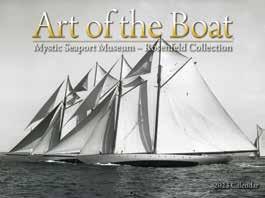
Member Burgee Mug

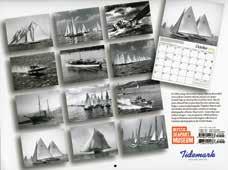
stone Mystic Seaport
DON

22 / Holiday Gift Giving 2023 Art of the Boat Wall Calendar Featuring beautiful, iconic images from the Rosenfeld Collection at Mystic Seaport Museum, we offer our 2023 Art of the Boat wall calendar. $15.99 Size 13 3/4”w x 10 1/4”h, opens to 13 3/4”w x 20 1/2”h
Our white
Museum Burgee 12 oz mug features the Museum’s Members’ burgee to remind you of your wonderful times at the Museum as you enjoy your morning beverage. $18.00
’ T MISS IT! MEMBERS ’ HOLIDAY DOUBLE DISCOUNT SHOPPING DAYS AT OUR GIFT STORE AND ONLINE! MARK YOUR CALENDAR: Friday, November 25, 2022, through Sunday, December 4, 2022 Enjoy 20% off almost everything in the store and online.* To shop online, visit shop.mysticseaport.org Use code: MYSTICMEMBER *excluding sale and promotional items.
GIFT GIVING
Our
This
$75.00
$20.00
Old Wood Boat
Old Wood Boat by Nikki McClure tells the story of a boat’s transformation from beached to adventure-worthy, told from the boat’s point of view. An old boat sits in the yard, her mast broken and thickets of blackberries growing across her decks.

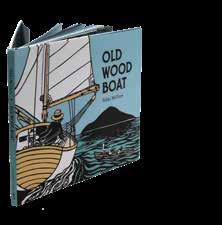
L. Francis Herreshoff: Yacht Designer, Volume I L. Francis Herreshoff: The Flowering of Genius, Volume II
L. Francis Herreshoff (1890-1972) was the most remarkable yacht designer of his time. Beginning his career in the shadow of his famous father, Nathanael G. Herreshoff, he emerged to become a designer who approached the perfection of form in yacht design. Maritime author, publisher, and professional mariner Roger C. Taylor brings Herreshoff’s personality to life, with its artistic and scientific genius, prejudices, omniscience, shyness, quiet friendliness, inward pain, and generosity in this two-volume detailed biography.
Volume I, $65.00 | Volume II, $75.00

Deck Prisms (out of stock until December)

In the days before electricity, light below a vessel’s deck was limited to candles, oil and kerosene lamps. A clever solution for the light problem was the deck prism. Laid flush into the deck, the prism point drew light down below decks. This prism is an exact reproduction of the Museum’s last remaining original Charles W. Morgan deck prism.
Large: $32.95, approximate dimensions, 4 1/2”h x 4 1/2”w
Small: $22.95, approximate dimensions, 3 1/4”h x 3”w
GIFT OF MEMBERSHIP
GIFT GIVING MADE EASY.
Give friends and family the gift of Membership, a gift as unique as they are.
Your loved ones will enjoy free year-round admission, discounts at our stores and restaurants, a Members-only evening in February to view the new Sargent, Whistler & Venetian Glass: American Artists and the Magic of Murano exhibition, and so much more.
your gift certificate today and wrap it up!
easy.
GIVE THE
Download
It’s gift giving made
To purchase, call 860.572.5339 or visit www.mysticseaport.org/gift Holiday Gift Giving / 23
$75.00
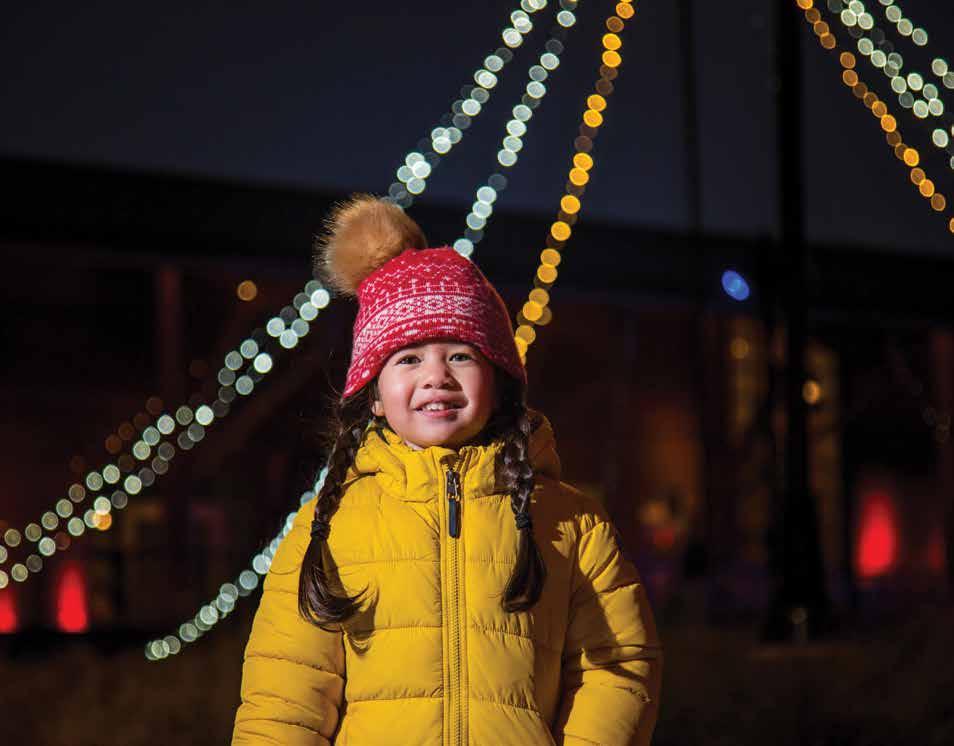
MYSTIC SEAPORT MUSEUM 75 Greenmanville Avenue PO Box 6000 Mystic, CT 06355-0990 Lantern Light Village tickets on sale now! Members enjoy $5 off! www.mysticseaport.org/lanternlightvillage OCTOBER 15 Sargent, Whistler, and Venetian Glass: American Artists and the Magic of Murano Opens 15-16 PILOTS Weekend 17-22 Member Mornings: Sargent, Whistler, and Venetian Glass: American Artists and the Magic of Murano 21-23 Mystic Film Festival 22-23 Visitor Pumpkin Carving 25-29 Jack-o’-Lantern Walk 26 America and the Sea Award Gala 31 Trick-or-Treat Community Event NOVEMBER 17 Member Talk: News from the Shipyard 25-27 Field Days 25-30 Member Double Discount Days 26 Tree Lighting and Boat Parade DECEMBER 1-4 Member Double Discount Days 2, 3, 9, 10, 16, 17 Lantern Light Village 18 Community Carol Sing 29, 30, 31 Holiday Magic 31 New Year’s Eve Celebration for Families 2023 upcoming Holiday Magic (continues through Jan 1) Adventure Series Ice Festival Member Evenings Pirate Days PILOTS Weekend Member Annual Meeting FOR DATES AND MORE www.mysticseaport.org/events
























 By Quentin Snediker, Clark Senior Curator for Watercraft
By Quentin Snediker, Clark Senior Curator for Watercraft







 By Christina Connett Brophy, Ph.D., Senior Vice President of Curatorial Affairs
By Christina Connett Brophy, Ph.D., Senior Vice President of Curatorial Affairs









